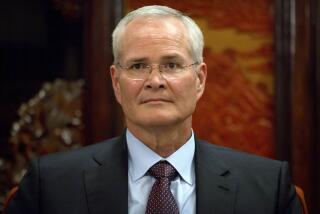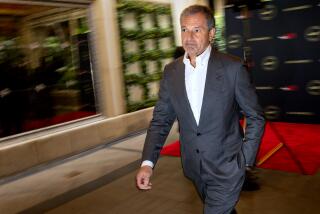BankAmerica Board Meets Amid Crisis
- Share via
BankAmerica’s board of directors meets here today and Monday in a climate of continuing crisis and mounting criticism for its apparent failure to act to reverse the dangerous slide at the nation’s second-largest banking company.
The bank’s 14 directors--particularly the 11 outside directors who do not hold executive positions in the company--find themselves in a wicked vise. They are under increasing pressure from investors, analysts and customers to do something to halt the bank’s massive losses.
At the same time, they seem crippled by takeover threats, a fear of liability claims, a tradition of board passivity and unalterable economic conditions that are punishing the bank for its previous excesses.
In the face of these pressures, BankAmerica’s board has, at least until now, rallied around management and retreated from public scrutiny. It has rejected calls for the replacement of Chief Executive Samuel H. Armacost and resisted a merger offer from California’s big and healthy First Interstate Bancorp.
In the past, a handful of board members has been willing to discuss BankAmerica business with reporters, usually on a not-for-attribution basis. But none of the 11 outside directors contacted last week would talk about board matters for this article.
The board will meet informally this afternoon and this evening and formally on Monday at the bank’s downtown Los Angeles office. The agenda has not been made public.
Many BankAmerica watchers are perplexed by the apparent inaction of the board in light of continuing huge losses, high turnover among top executives and a stock price that has fallen to $12 a share from $22 in less than two years. But interviews with bank officials, sources close to board members, industry analysts and investment bankers give some insight into why the BankAmerica board behaves as it does.
The outside directors average nearly 64 years of age and nine years of service on the board. No new outsider has agreed to serve on the board since 1982, while in the same period 10 outside directors have left the board because they reached the mandatory retirement age of 70 or for other, usually unspecified, reasons.
Resigned in Frustration
Charles R. Schwab, 48, who assumed a board seat in 1983 when BankAmerica bought his discount brokerage firm, resigned from the board last month. He has said he was frustrated by his inability to persuade the board that radical action is needed to improve BankAmerica’s fortunes.
Most of the remaining outside directors are former chief executives of major firms and several have faced takeover attempts or were ousted from their posts. Only one board member, former Transamerica Corp. Chief Executive John R. Beckett, owns a sizeable chunk of BankAmerica stock.
All these factors combine to create a collective psyche that tends to be weary, supportive of management, resistant to outside pressure and deeply concerned with projecting an image of institutional solidity.
“These men have been through the battles and put a lot of value on supporting management, because they don’t have the fire in their guts that younger, more active CEOs (chief executive officers) have,” a source familiar with board affairs said.
“They are not likely to want to force the issues that people are concerned about, like the level of reserves or the quality of the loan portfolio. It’s not their nature to challenge what management is saying.”
Having been chief executives, many board members feel a kinship with Armacost, who has been under constant fire for the past 18 months as the bank has suffered hundreds of millions of dollars in losses, a costly and embarrassing real estate scandal, the defections of many top officers and rough treatment in the press.
Understand Pressures
Armacost is glad to have such men on his board. Reflecting on the shared bonds of chief executives, he said in an interview last month, “Nobody else can understand the pressures, the glare of publicity, the nonsense that comes up at shareholders’ meetings.”
BankAmerica board member C. R. Dahl, the former head of Crown Zellerbach who was removed by a rebellious board of directors, “is a management supporter almost by reflex,” said Donald Winks, a former executive at the San Francisco-based forest products company.
Crown Zellerbach, which like BankAmerica was widely criticized for being one of the poorest performers in its industry, was taken over last year by financier Sir James Goldsmith, who broke up the company and sold most of the parts.
Several BankAmerica directors have had to fend off unwanted suitors for their companies. Philip M. Hawley, chairman and chief executive of Carter Hawley Hale Stores, successfully stopped a takeover attempt by The Limited. Cornell C. Maier, chairman of Kaiser Aluminum & Chemical, is currently fighting a takeover bid from Tulsa investor Joseph Frates.
There are no women on the board. There is one black, Andrew F. Brimmer, a former Federal Reserve Board governor and now a Washington consultant, and one Latino, Ignacio E. Lozano Jr., publisher of the Spanish-language Los Angeles newspaper La Opinion.
Other outside board members are Roy L. Ash, former chief executive of Litton Industries and AM International and former director of the federal Office of Management and Budget; John R. Grey, who retired last year as president of Chevron, citing poor health; David S. Lewis, retired chairman of General Dynamics; Robert S. McNamara, former secretary of defense and former president of Ford Motor Co. and the World Bank; and Ruben F. Mettler, chief executive of TRW.
Three Insiders on Board
Three BankAmerica insiders sit on the board: Armacost, Chairman Leland S. Prussia and Richard P. Cooley, chairman of the company’s Seafirst subsidiary.
One factor that tends to produce caution among board members is the growing likelihood that any action it takes or does not take will result in a lawsuit. The bank currently is defending 20 lawsuits that name directors as defendants, officials said.
The problem is compounded by BankAmerica’s inability to buy commercial liability insurance for its directors and officers. The firm’s insurance was canceled last year after it sued its insurers seeking recovery of $95 million lost in an alleged real estate fraud. BankAmerica was forced to create a captive insurance subsidiary, BA Insurance (Cayman) Ltd., chartered in the Caribbean.
The bank would not divulge the limits of the coverage but it almost certainly could not protect directors against the hundreds of millions of dollars in potential claims. Any court-ordered damages above the coverage limit must be paid out of the directors’ own pockets.
“Directors have become targets for lawsuits that were unheard of years ago,” said Harvey H. Rosen, an attorney who specializes in banks at the Los Angeles law firm of Rosen, Wachtell & Gilbert. “They are asking themselves, ‘Why am I putting my personal assets on the line? I’m not a banker. I can’t be involved in the day-to-day affairs of the bank to the extent necessary to protect my interests.’
Many Frightened Away
“I can’t think of a single incentive that could be offered that would make it attractive for an outside director to participate. A lot of competent people are being frightened away.”
Sal Serrantino, president of California Research Corp., which does consulting for banks and thrifts, expressed the opinion that BankAmerica’s directors are unresponsive to calls for drastic action in part because they are not affected as stockholders by the company’s poor performance.
As of March 20, the 11 outside directors as a group owned 36,026 shares of BankAmerica stock, representing 0.02% of the total of 153.8 million shares. Beckett alone owned two-thirds of the directors’ combined holdings.
“They do not have the normal kinds of concerns that directors with sizable amounts of ownership have,” Serrantino said.
More to Read
Sign up for Essential California
The most important California stories and recommendations in your inbox every morning.
You may occasionally receive promotional content from the Los Angeles Times.













